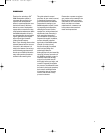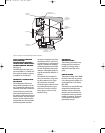
CHAPTER 2 – UNPACKING THE S4800 SYSTEM
All components of the S4800 sys-
tem have been very carefully
packed for maximum protection
against damage.
As with any superior audio product,
i
t is advisable to keep the original
packing materials in case it is
n
ecessary to transport the S4800
system.
Because of the bulk and weight of
this loudspeaker, at least two peo-
ple are required to unpack it in the
following manner: Open the front as
well as the top of the carton. Slowly
and carefully “walk” the loud-
speaker in its Styrofoam
™
end
pads out of the carton. Two people
may then lift the system out of the
end pads.
T
he four spiked feet are pre-
installed in the bottom of the S4800
i
n four locations. Four metal coast-
ers are packed in the end pads.
These are to be placed between
the feet and the floor for further
protection of floor coverings. See
Figure 6.
Figure 6. Inserting
spiked feet.
CHAPTER 3 – SELECTING CABLE
Speaker wire and interconnecting
cables are critical components in
any audio system. With a system
such as the S4800, they assume a
new level of importance.
S4800 loudspeakers are internally
wired with high-quality copper
Monster Cable, specially designed
for JBL. The same care that was
given to the selection of internal
system wiring should be afforded
to the selection and application of
the cables that will connect S4800
loudspeakers to other system
components.
It is advisable to use high-quality
wire, such as Monster Cable, and
to select the highest-grade wire
available from the manufacturer
.
Many manufacturers produce
audiophile cables worth consider
-
ing for the S4800. As with all
elec-
tronics and associated compo-
nents, however
, every manufacturer
offers products of varying quality
to suit a range of budgets and
applications.
We recommend using an audio-
phile-quality speaker wire of not
less than 16 gauge for connections
up to 15 feet (5 meters) as a mini-
mum requirement. If your connec-
tions will be longer, heavier-gauge
wire is recommended. JBL special-
ist dealers have the experience
and knowledge to recommend
suitable speaker wire to best
complement a particular system.
The amount of speaker wire
required will depend on the dis-
tance between the loudspeakers
and amplifier(s), how many ampli-
fiers will be used, and the method
you select for connecting the
amplifier and loudspeakers
(passive or bi-wire; see Chapter 6).
For maximum signal purity, it is
advisable to locate the amplifier(s)
as close as possible to the loud
-
speakers, even if this means that
a longer distance will be needed
between the amplifier(s) and
preamplifier.
Both the left and right speaker/
amplifier connections should be
the same length. If the distance
between one speaker and the
amplifier(s) is greater than the
other speaker and amplifier(s),
use the longer length for both
connections.
For bi-wire connections, the same
type of wires may be used for
both the low-frequency and high-
frequency sections to reduce wire
effects (resistance, inductance,
etc.) and to avoid intermodulation
of low and high frequencies in the
wires. Specialized wires for low-
frequency and high-frequency
sections may yield excellent
results. Whatever wires are used,
be sure that the low-frequency
wires are as short as possible,
and the left and right wires for
each section are the same length.
8
S4800 OM 10/11/05 1:51 PM Page 8


















